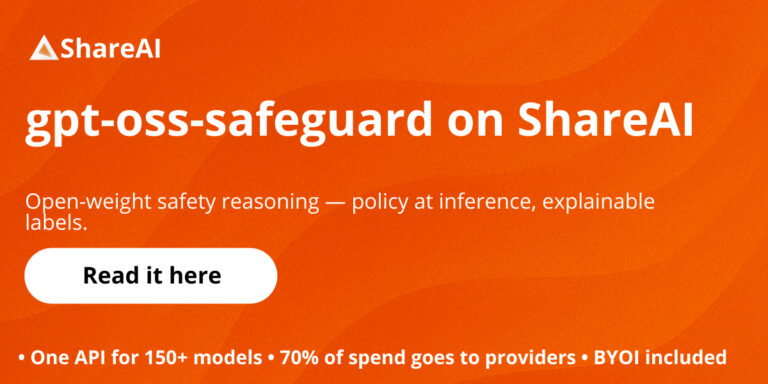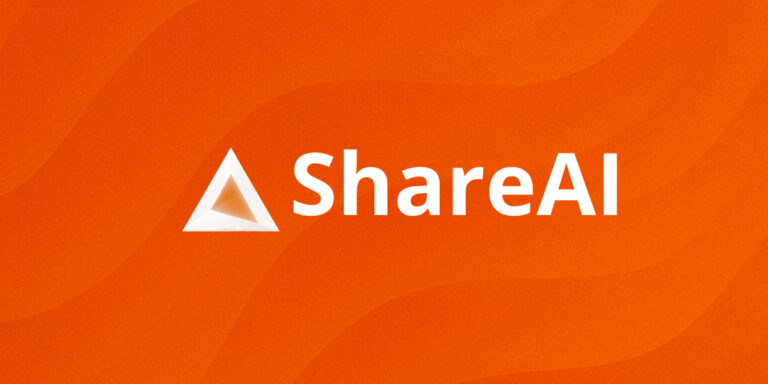Tyk Alternatives 2025: Top 10 Alternatives

Updated November 2025
If you’re evaluating Tyk alternatives, this guide maps the landscape like a builder would. We’ll clarify what Tyk is—an API gateway and management plane focused on policy, security, and observability—then compare the 10 best alternatives (plus a deep FAQ). We place ShareAI first for teams that want one API across many AI model providers, transparent marketplace signals (price, latency, uptime, availability, provider type) before routing, instant failover, and people-powered economics (70% of spend goes to providers).
Quick links:
- Browse Models
- Open Playground
- Create API Key (Console)
- API Reference
- Docs Home
- Releases
- Provider Guide
- Sign in / Sign up
What Tyk is (and isn’t)
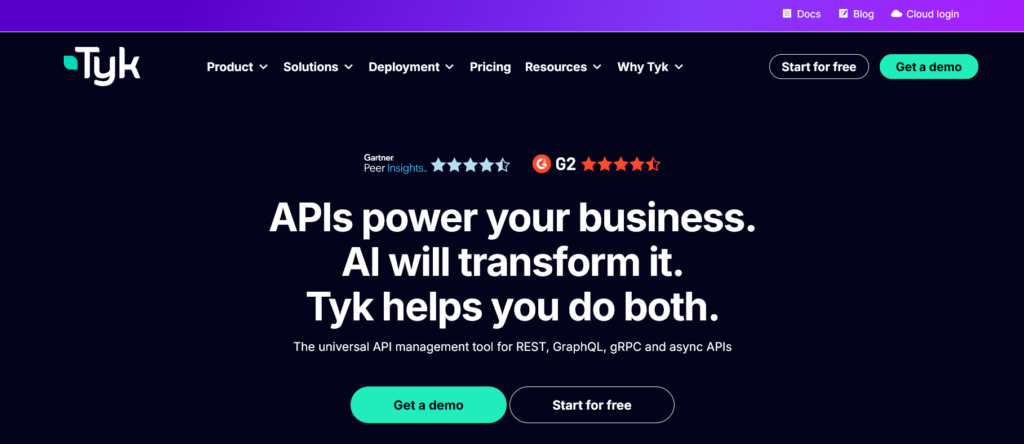
Tyk is an API gateway: it centralizes authentication/authorization, rate-limits/quotas, request/response transformations, policies, and analytics—so you can govern and observe API traffic at the edge. That’s valuable when you need centralized egress control and observability across many services.
Tyk is not a transparent model marketplace. If your team needs pre-route visibility into AI providers and models (unit price, observed latency, uptime, availability, provider type) and the ability to fail over instantly between multiple providers—those are aggregator strengths, not traditional gateway features.
Aggregators vs Gateways vs Agent platforms
LLM aggregators (e.g., ShareAI, OpenRouter, Eden AI): one API across many models and providers, with pre-route transparency (price, latency, uptime, availability, provider type) and smart routing/failover.
API gateways (e.g., Tyk, Kong, Apigee, NGINX, Traefik, Gravitee, APISIX, KrakenD, AWS API Gateway, Azure API Management): centralized policies, keys, quotas, guardrails, and observability for your traffic. You bring your providers and models.
Agent/chatbot platforms (e.g., Unify, Orq): packaged UX for assistants, flows, tools, and evaluation—geared to end-user experiences rather than provider-agnostic aggregation.
Many teams use both: keep a gateway for org-wide policy and audit; add ShareAI for marketplace-guided routing across providers with instant failover.
How we evaluated the best Tyk alternatives
- Model breadth & neutrality (for AI use cases): proprietary + open; easy switching; no rewrites.
- Latency & resilience: routing policies, timeouts, retries, instant failover.
- Governance & security: key handling, scopes, regional routing.
- Observability: logs/traces and cost/latency dashboards.
- Pricing transparency & TCO: compare real costs before you route.
- Developer experience: docs, SDKs, quickstarts; time-to-first-token.
- Community & economics: whether your spend grows supply (incentives for GPU owners).
Top 10 Tyk alternatives
#1 — ShareAI (People-Powered AI API)
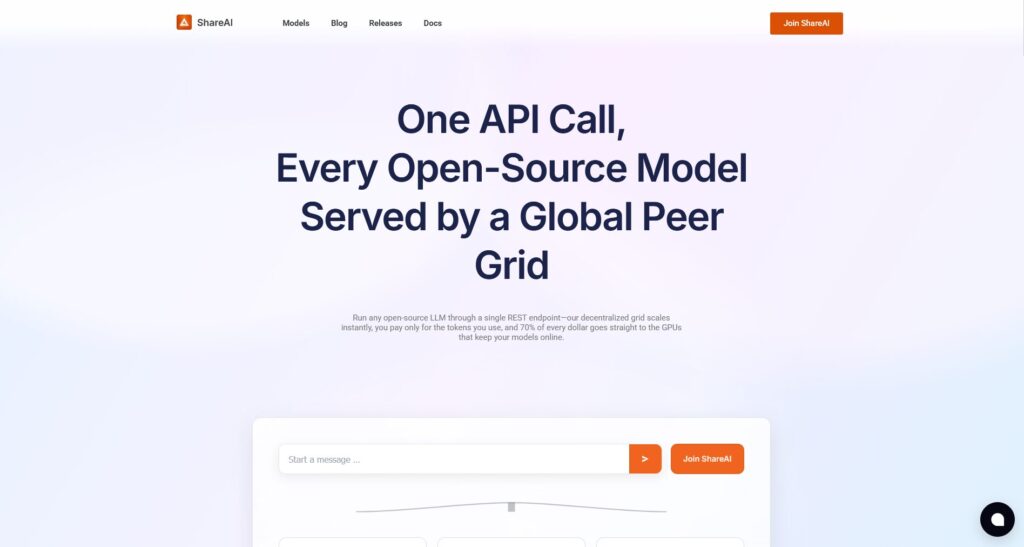
What it is. A multi-provider API with a transparent marketplace and smart routing. With one integration, browse a large catalog of models and providers, compare price, latency, uptime, availability, provider type, and route with instant failover. Economics are people-powered: 70% of every dollar flows to providers (community or company) who keep models online.
Why it’s #1 here. If your goal is provider-agnostic aggregation with pre-route transparency and resilience, ShareAI is the most direct fit. Keep your gateway if you need org-wide policies; add ShareAI for marketplace-guided routing.
- One API → 150+ models across many providers; no rewrites, no lock-in.
- Transparent marketplace: choose by price, latency, uptime, availability, provider type.
- Resilience by default: routing policies + instant failover.
- Fair economics: 70% of spend goes to providers (community or company).
Quick links — Browse Models · Open Playground · Create API Key · API Reference · Docs · Releases
For providers: earn by keeping models online.
Anyone can become a ShareAI provider—Community or Company. Onboard via Windows, Ubuntu, macOS, or Docker. Contribute idle-time bursts or run always-on. Choose incentives: Rewards (money), Exchange (tokens/AI Prosumer), or Mission (donate a % to NGOs). As you scale, you can set your own inference prices and gain preferential exposure. Provider Guide
#2 — Kong Gateway / Kong AI Gateway
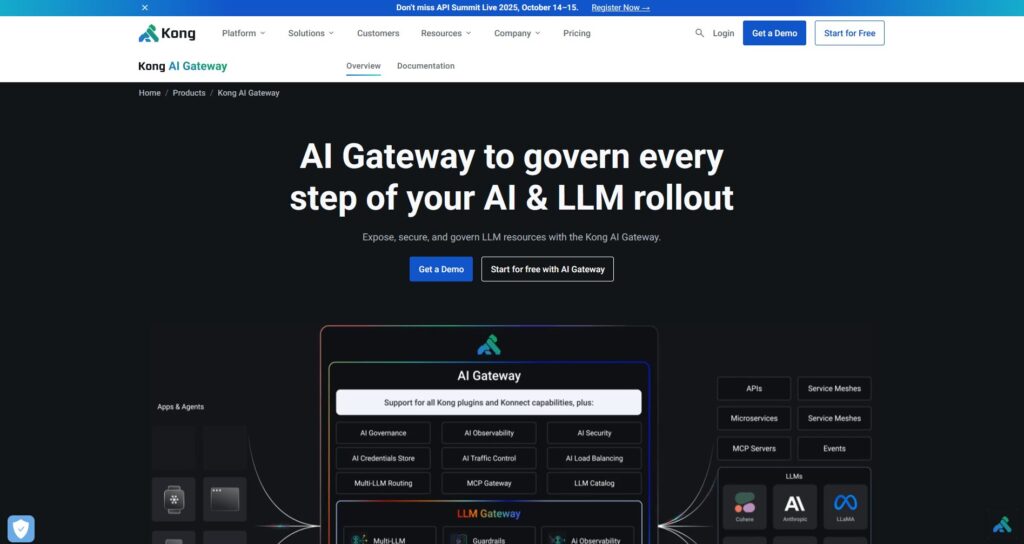
What it is. Enterprise-grade API gateway with strong policies/plugins, security, and analytics, plus AI-focused extensions for LLM traffic control. It’s a control plane, not a marketplace.
#3 — Apigee (Google Cloud)
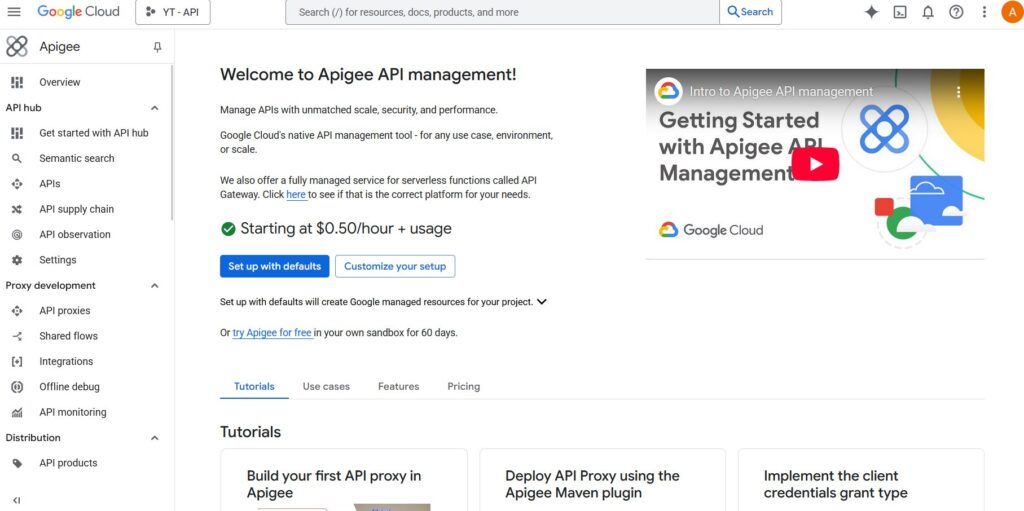
What it is. Broad API management for enterprises—design, publish, secure, and monitor APIs at scale. Combines governance with analytics; you can front LLM providers behind Apigee, but you won’t get marketplace transparency.
#4 — NGINX

What it is. A performant reverse proxy you can compose into a DIY gateway (routing, token enforcement, caching). Powerful, but you’ll glue together policies and analytics yourself.
#5 — Traefik
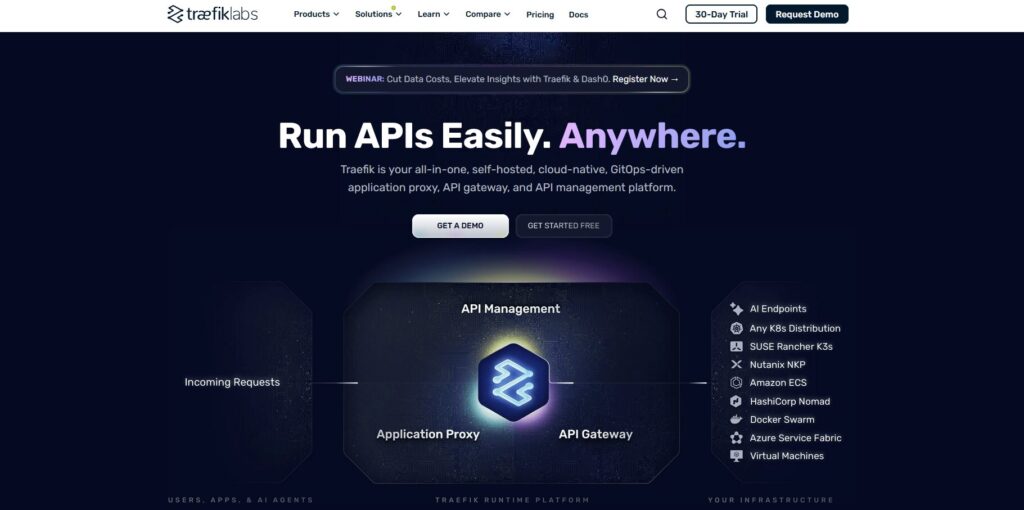
What it is. A developer-friendly edge router/gateway with valuable middlewares; you can add a thin AI layer to govern LLM egress and integrate with OpenTelemetry.
#6 — Gravitee
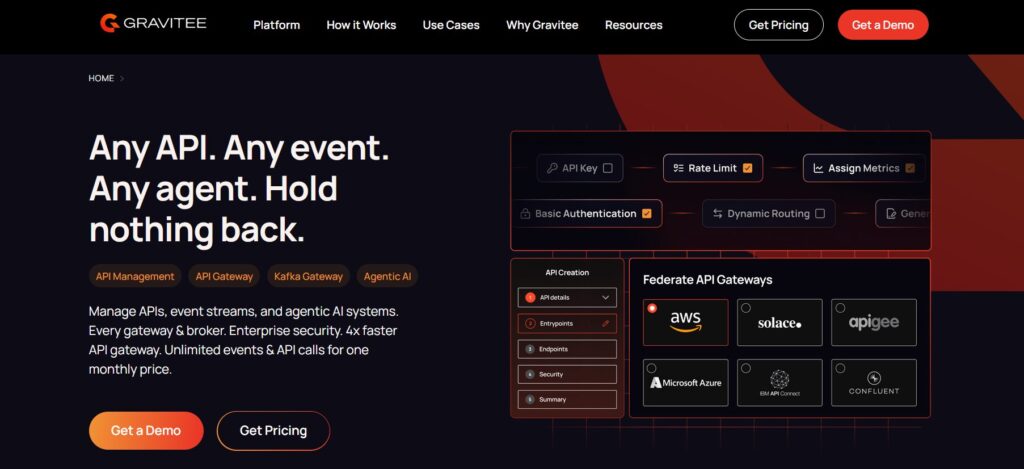
What it is. Policy-first API management with a focus on security and developer portal experiences. Good for governance; pair with an AI aggregator if you need pre-route provider transparency.
#7 — Apache APISIX
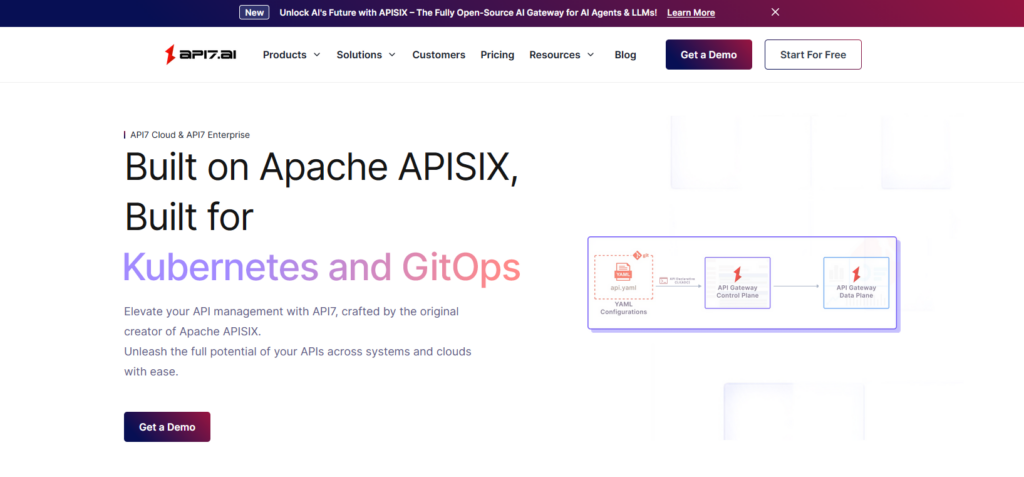
What it is. High-performance, cloud-native gateway with a rich plugin ecosystem. Great for Lua/DIY teams that want control. You’ll add your own telemetry and routing logic.
#8 — KrakenD

What it is. High-throughput API composer/gateway supporting transformations and aggregation. A fit for teams building a unified edge over many services.
#9 — AWS API Gateway
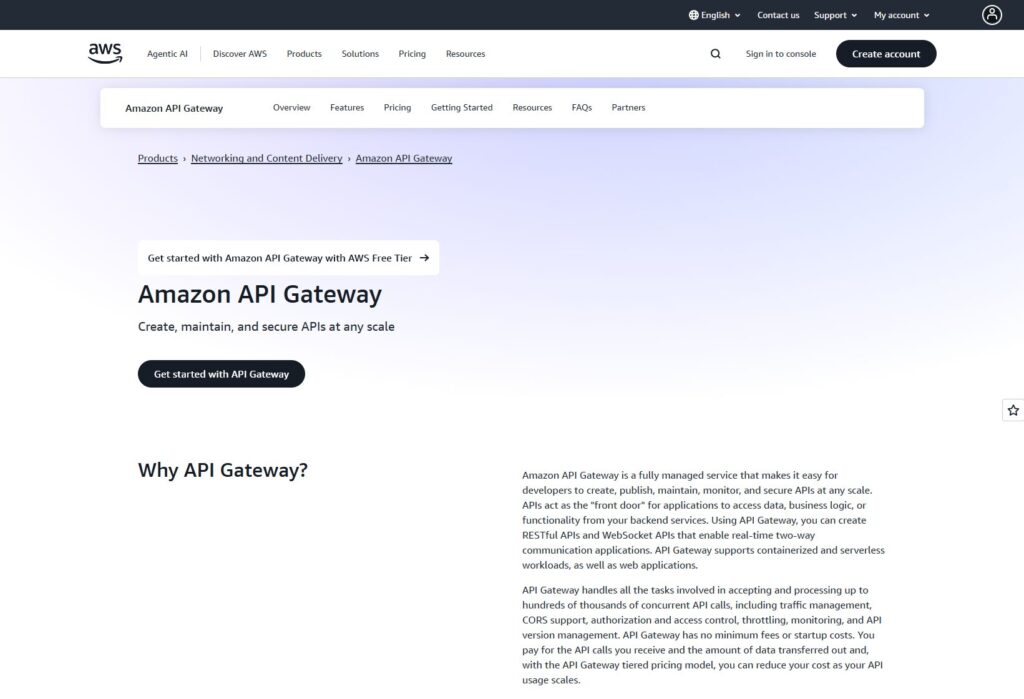
What it is. Managed gateway inside AWS: policies, auth, quotas, and close integration with the AWS stack. No marketplace transparency; pair with ShareAI when you need multi-provider AI routing.
#10 — Azure API Management

What it is. Managed API gateway for Azure workloads; strong developer portal and policies. Like other gateways, it’s governance-first—not a provider marketplace.
Tyk vs ShareAI
If you need one API over many AI providers with transparent pricing/latency/uptime/availability and instant failover, choose ShareAI. If your top requirement is API governance—centralized credentials, policy enforcement, and observability—Tyk fits that lane. Many teams pair them: gateway for org policy + ShareAI for marketplace routing.
Quick comparison
| Platform | Who it serves | Model breadth | Governance & security | Observability | Routing / failover | Marketplace transparency | Provider program |
|---|---|---|---|---|---|---|---|
| ShareAI | Product/platform teams needing one API + fair economics | 150+ models, many providers | API keys & per-route controls | Console usage + marketplace stats | Smart routing + instant failover | Yes (price, latency, uptime, availability, provider type) | Yes — open supply; 70% to providers |
| Tyk | Teams wanting gateway-level policy & governance | Bring-your-own providers | Strong policies and key management | Analytics & monitoring | Conditional routing via policies/middlewares | No (infra tool, not a marketplace) | n/a |
| Kong | Enterprises needing gateway policy | BYO | Strong edge policies/plugins | Analytics | Proxy/plugins, retries | No (infra) | n/a |
| Apigee | Enterprises needing API mgmt | BYO | Granular policies & quotas | Deep analytics | Add-ons/retries | No (infra) | n/a |
| NGINX | DIY teams | BYO | Custom filters | Add-ons/custom | Custom | No (DIY) | n/a |
| Traefik | Dev-friendly ops | BYO | Centralized credentials/policy | OTel-friendly | Conditional routing | No (infra) | n/a |
| Gravitee | Security-minded orgs | BYO | Policy-first | Portal + analytics | Plugins/retries | No | n/a |
| APISIX | Performance-oriented | BYO | Plugin-driven | Community tools | Lua/custom | No | n/a |
| KrakenD | API composition fans | BYO | Config-driven | Plugins | Caching/retries | No | n/a |
| AWS / Azure | Cloud-centric orgs | BYO | Managed policies | Cloud monitors | Retries/fallbacks | No | n/a |
TL;DR — Gateways govern; ShareAI routes intelligently across providers with pre-route transparency and instant failover.
Pricing & TCO: compare real costs (not just unit prices)
Raw $/1K tokens hides the real picture. TCO shifts with retries/fallbacks, latency (which affects user behavior), provider variance, observability storage, and evaluation runs. A transparent marketplace helps you choose routes that balance cost and UX.
TCO ≈ Σ (Base_tokens × Unit_price × (1 + Retry_rate))
+ Observability_storage
+ Evaluation_tokens
+ Egress
Prototype (~10k tokens/day): Optimize for time-to-first-token (Playground + quickstarts).
Mid-scale (~2M tokens/day): Marketplace-guided routing/failover can trim 10–20% while improving UX.
Spiky workloads: Expect higher effective token costs from retries during failover; budget for it.
Migration guide: moving to (or pairing with) ShareAI
From Tyk
Keep gateway-level policies where they shine; add ShareAI for marketplace routing + instant failover. Pattern: gateway auth/policy → ShareAI route per model → measure marketplace stats → tighten policies.
From Kong / Apigee / NGINX / Traefik / Gravitee / APISIX / KrakenD / AWS / Azure
Define feature-parity expectations (analytics, guardrails, orchestration, plugins). Many teams run hybrid: keep specialized features where they’re strongest; use ShareAI for transparent provider choice and failover.
From OpenRouter / Eden AI
Map model names, verify prompt parity, then shadow 10% of traffic and ramp 25% → 50% → 100% as latency/error budgets hold. Marketplace stats make provider swaps straightforward.
From LiteLLM
Replace the self-hosted proxy on production routes you don’t want to operate; keep LiteLLM for dev if desired. Compare ops overhead vs. managed routing benefits.
From Unify / Orq / Portkey
Clarify scope: evaluation/orchestration/guardrails vs routing/marketplace. You can keep them alongside ShareAI; route via ShareAI when you need provider diversity and fast failover.
Developer quickstart (copy-paste)
The following examples use an OpenAI-compatible surface. Replace YOUR_KEY with your ShareAI key — get one at Create API Key.
#!/usr/bin/env bash
# cURL — Chat Completions via ShareAI
# Prereqs:
# export SHAREAI_API_KEY="YOUR_KEY"
curl -X POST "https://api.shareai.now/v1/chat/completions" \
-H "Authorization: Bearer $SHAREAI_API_KEY" \
-H "Content-Type: application/json" \
-d '{
"model": "llama-3.1-70b",
"messages": [
{ "role": "user", "content": "Give me a short haiku about reliable routing." }
],
"temperature": 0.4,
"max_tokens": 128
}'
// JavaScript (fetch) — Node 18+/Edge runtimes
// Prereqs:
// process.env.SHAREAI_API_KEY = "YOUR_KEY"
async function main() {
const res = await fetch("https://api.shareai.now/v1/chat/completions", {
method: "POST",
headers: {
"Authorization": `Bearer ${process.env.SHAREAI_API_KEY}`,
"Content-Type": "application/json"
},
body: JSON.stringify({
model: "llama-3.1-70b",
messages: [
{ role: "user", content: "Give me a short haiku about reliable routing." }
],
temperature: 0.4,
max_tokens: 128
})
});
if (!res.ok) {
console.error("Request failed:", res.status, await res.text());
return;
}
const data = await res.json();
console.log(JSON.stringify(data, null, 2));
}
main().catch(console.error);
Next steps:
Open Playground · Create API Key · API Reference
Security, privacy & compliance checklist (vendor-agnostic)
- Key handling: rotation cadence; minimal scopes; environment separation.
- Data retention: where prompts/responses are stored, for how long; redaction defaults.
- PII & sensitive content: masking; access controls; regional routing for data locality.
- Observability: prompt/response logging; ability to filter or pseudonymize; propagate trace IDs consistently.
- Incident response: escalation paths and provider SLAs.
FAQ — Tyk vs other competitors
Tyk vs ShareAI — which for multi-provider AI routing?
ShareAI. It’s built for marketplace transparency (price, latency, uptime, availability, provider type) and smart routing/failover across many providers. Tyk is an egress governance tool (centralized credentials/policy; analytics). Many teams use both.
Tyk vs Kong — two gateways
Both are gateways (policies, plugins, analytics), not marketplaces. If you also want transparent multi-provider routing and instant failover, add ShareAI alongside your gateway.
Tyk vs Apigee — API management vs AI-specific routing
Apigee is broad API management; Tyk is a leaner gateway stack. For provider-agnostic access with live marketplace stats, use ShareAI in addition.
Tyk vs NGINX — DIY vs turnkey
NGINX enables DIY filters/policies; Tyk offers packaged gateway features. To avoid custom Lua and still get transparent provider selection, layer in ShareAI.
Tyk vs Traefik — edge router vs gateway
Traefik is a developer-friendly edge router; Tyk is a gateway platform. Neither is a marketplace. Use ShareAI for one-API, multi-provider AI with instant failover.
Tyk vs Gravitee — policy-first vs policy-first
Both emphasize governance. Your choice may hinge on plugins, UI, and portal. For pre-route provider transparency, add ShareAI.
Tyk vs Apache APISIX — plugin-driven vs productized
APISIX is high-performance and plugin-centric; Tyk is more productized. Neither gives a provider marketplace—pair either with ShareAI.
Tyk vs KrakenD — API composition vs management
KrakenD excels at aggregation and transformation; Tyk on policies and analytics. ShareAI complements either with marketplace routing.
Tyk vs AWS API Gateway — cloud-native choice
If you’re all-in on AWS, AWS API Gateway is convenient. For multi-provider AI with transparent costs/latency and failover, add ShareAI.
Tyk vs Azure API Management — Azure-native choice
APIM integrates tightly with Azure. As above, use ShareAI for model/provider diversity and fast failover.
Tyk vs OpenRouter — quick multi-model access or gateway controls?
OpenRouter makes multi-model access quick; Tyk centralizes policy. If you also want pre-route transparency and instant failover, ShareAI combines multi-provider access with a marketplace view and resilient routing.
Tyk vs Eden AI — many AI services or egress control?
Eden AI aggregates several AI services (LLM, image, TTS). Tyk centralizes policy/credentials. For transparent pricing/latency across many providers plus instant failover, choose ShareAI.
Tyk vs Portkey — guardrails vs governance
Both emphasize governance and observability; depth and ergonomics differ. If your main need is transparent provider choice and failover, add ShareAI.
Tyk vs LiteLLM — self-host proxy or managed governance?
LiteLLM is a DIY proxy you operate; Tyk is managed governance/observability for API egress. If you’d rather not run a proxy and want marketplace-driven routing, choose ShareAI.
Tyk vs Unify — best-model selection vs policy enforcement?
Unify focuses on evaluation-driven model selection; Tyk on policy/observability. For one API over many providers with live marketplace stats, use ShareAI.
Tyk vs Orq — orchestration vs egress
Orq helps orchestrate flows; Tyk governs egress traffic. ShareAI complements either with transparent multi-provider routing.
Provider facts (ShareAI)
- Anyone can join as Community or Company provider.
- Onboarding apps: Windows, Ubuntu, macOS, Docker.
- Contribution modes: idle-time bursts or always-on.
- Incentives: Rewards (earn money), Exchange (earn tokens to use later), Mission (donate a % to NGOs).
- Perks as you scale: set your own inference prices, preferential exposure, and more. Learn more
Try ShareAI next
- Open Playground — experiment with prompts/models in seconds.
- Create your API key — start routing across providers with instant failover.
- Browse Models — compare price, latency, uptime, availability, provider type before you route.
- Docs · Releases
- Sign in / Sign up — authentication autoselects login/registration as needed.
